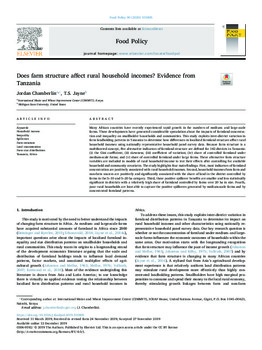Mostrar el registro sencillo del ítem
Does farm structure affect rural household incomes? Evidence from Tanzania
| Autor: | Chamberlin, J. |
| Autor: | Jayne, T.S. |
| Año: | 2020 |
| ISSN: | 0306-9192 (Print) |
| URI: | https://hdl.handle.net/10883/20649 |
| Formato: | |
| Lenguaje: | English |
| Editor: | Elsevier |
| Copyright: | CIMMYT manages Intellectual Assets as International Public Goods. The user is free to download, print, store and share this work. In case you want to translate or create any other derivative work and share or distribute such translation/derivative work, please contact CIMMYT-Knowledge-Center@cgiar.org indicating the work you want to use and the kind of use you intend; CIMMYT will contact you with the suitable license for that purpose. |
| Tipo: | Article |
| Lugar de publicación: | London (United Kingdom) |
| Volumen: | 90 |
| DOI: | 10.1016/j.foodpol.2019.101805 |
| Descripción: | Many African countries have recently experienced rapid growth in the numbers of medium- and large-scale farms. These developments have generated considerable speculation about the impacts of farmland concentration and inequality on smallholder households and communities. This study exploits inter-district variation in farm landholding patterns in Tanzania to determine how differences in localized farmland structure affect rural household incomes using nationally representative household panel survey data. Because farm structure is a multifaceted concept, five alternative indicators of farmland structure are defined for 142 districts in Tanzania: (i) the Gini coefficient; (ii) skewness; (iii) coefficient of variation; (iv) share of controlled farmland under medium-scale farms; and (v) share of controlled farmland under large farms. These alternative farm structure variables are included in models of rural household income to test their effects after controlling for available household and community covariates. The study highlights four main findings. First, most indicators of farmland concentration are positively associated with rural household incomes. Second, household incomes from farm and non-farm sources are positively and significantly associated with the share of land in the district controlled by farms in the 5?10 and 5?20 ha category. Third, these positive spillover benefits are smaller and less statistically significant in districts with a relatively high share of farmland controlled by farms over 20 ha in size. Fourth, poor rural households are least able to capture the positive spillovers generated by medium-scale farms and by concentrated farmland patterns. |
| País: | UNITED REPUBLIC OF TANZANIA |
| Agrovoc: | HOUSEHOLD INCOME |
| Agrovoc: | FARM STRUCTURE |
| Agrovoc: | LAND CONCENTRATION |
| Agrovoc: | FARM SIZE |
| Notas: | The dataset related with this article is only referential |
| Datasets relacionados: | https://ars.els-cdn.com/content/image/1-s2.0-S030691921930627X-mmc1.docx |
| Revista: | Food Policy |
| Número de artículo: | 101805 |
Ficheros en el ítem
Este ítem aparece en la(s) siguiente(s) colección(ones)
-
Socioeconomics
Including topics such as farming systems, markets, impact & targeting, innovations, and GIS

